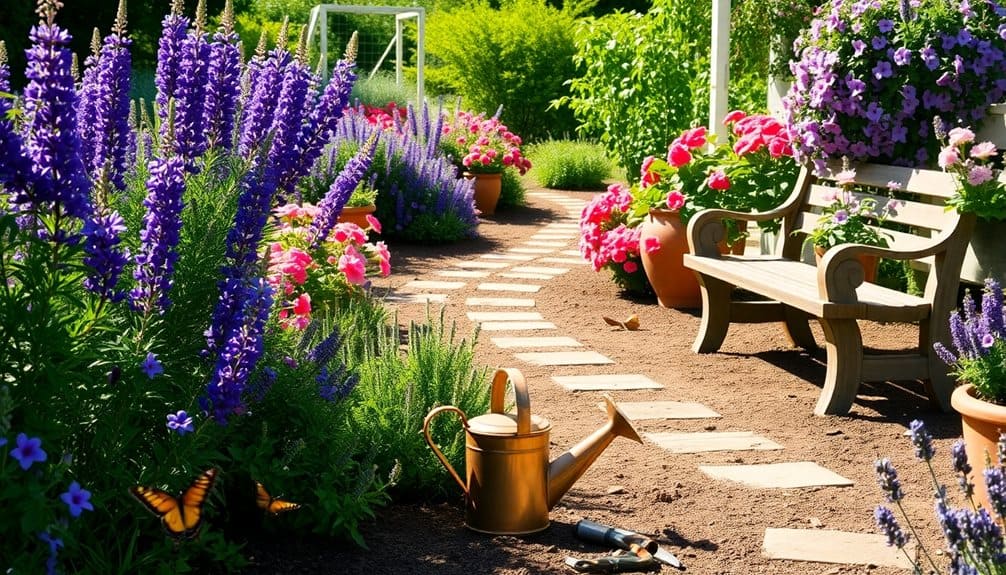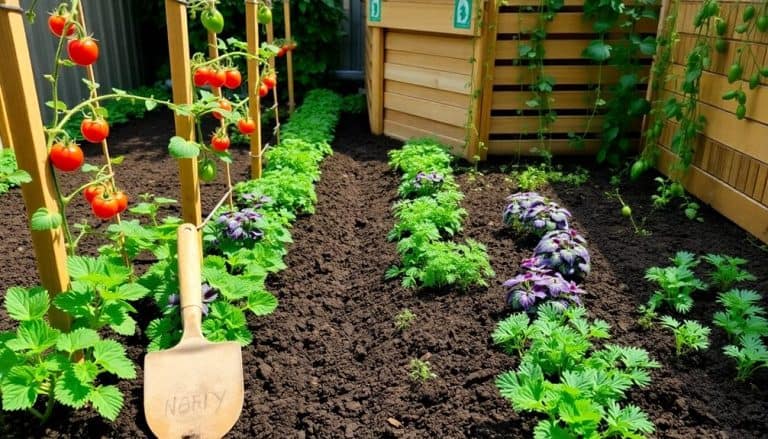This website contains affiliate links. Some products are gifted by the brand to test. As an Amazon Associate, I earn from qualifying purchases. The content on this website was created with the help of AI.
You’ll transform your outdoor space into a thriving flower garden through systematic design implementation. Start with a thorough site analysis, documenting sun patterns and conducting soil tests for pH and nutrient levels. Select your garden style (formal, cottage, or contemporary) and develop a cohesive color scheme using the 60-30-10 rule. Layer plantings with ground covers, reliable bloomers, and architectural specimens while incorporating year-round interest through strategic bloom timing. Install proper infrastructure including irrigation zones, pathways, and drainage solutions. Establish maintenance protocols for daily, weekly, and seasonal tasks. The following steps will reveal your garden’s full potential through expert-level techniques and proven design principles.
Key Takeaways
- Analyze your garden space by measuring dimensions, documenting sun exposure, and testing soil composition for optimal plant growth conditions.
- Select a garden style and color scheme that matches your maintenance capacity and aesthetic preferences using the 60-30-10 rule.
- Create a planting grid with layered heights, incorporating ground covers, middle-story bloomers, and architectural background plants.
- Install proper infrastructure including irrigation systems, pathways, and lighting while planning for year-round maintenance requirements.
- Ensure proper drainage with graded slopes, French drains, and permeable path materials to prevent water accumulation issues.
Assess Your Garden Space
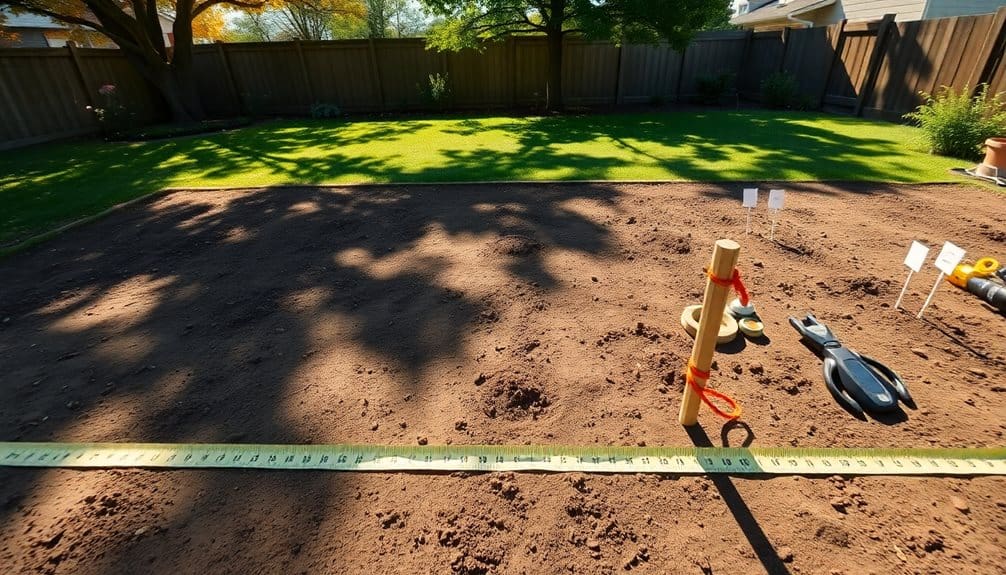
Before designing your flower garden, you’ll need to conduct a thorough site analysis of your available space. Measure the exact dimensions of your planting area, noting any boundaries, structures, or existing vegetation. Document the sun exposure patterns throughout the day, as this will determine your plant selection criteria.
Analyze your soil composition by conducting a pH test and evaluating its texture, drainage capabilities, and organic matter content. You’ll want to identify any potential drainage issues, soil compaction, or nutrient deficiencies that could affect plant growth. Map out underground utilities, irrigation systems, and root zones of established trees that might interfere with new plantings.
Consider your hardiness zone and microclimate factors, including wind patterns, frost pockets, and heat reflection from nearby structures. Take note of the slope gradient and any erosion concerns that might require terracing or strategic plant placement. Factor in accessibility requirements for maintenance, ensuring adequate pathways and working space between planting beds. Document existing microclimates created by walls, fences, or mature trees, as these can greatly impact plant performance and survival rates. When planning your garden’s watering system, choose a hose that maintains flexibility in temperatures as low as 35 degrees Fahrenheit to ensure year-round functionality.
Define Your Garden Style

In accordance with your gardening vision, selecting a distinct garden style serves as the foundation for all subsequent design decisions. Common styles include formal gardens with symmetrical layouts and geometric patterns, cottage gardens featuring informal, dense plantings, and contemporary gardens emphasizing clean lines and minimal plant varieties. You’ll need to determine which aesthetic aligns with your property’s architecture and personal preferences.
Consider the maintenance requirements of each style. Formal gardens demand regular pruning and precise upkeep to maintain their structured appearance. Cottage gardens, while appearing casual, require strategic plant placement and seasonal management to prevent overcrowding. Contemporary gardens typically need less maintenance but require careful attention to plant spacing and form.
Your chosen style will dictate plant selection, hardscaping materials, and structural elements. For formal gardens, select uniform hedging plants and matching container specimens. Cottage gardens benefit from self-seeding perennials and climbing varieties. Contemporary gardens often incorporate architectural plants with bold forms and limited color palettes. Document your style preferences in a design brief to guarantee consistency throughout the implementation process. For year-round growing potential, consider incorporating a polycarbonate greenhouse to extend your gardening season and protect delicate specimens.
Test Your Soil

Understanding your soil composition serves as the foundation of successful flower garden design. You’ll need to assess both pH levels and nutrient content to guarantee ideal growing conditions for your selected flora. Purchase a soil testing kit from your local garden center or send samples to a professional lab for thorough analysis of macronutrients (N-P-K) and micronutrients.
Your soil’s texture and structure also play significant roles in plant health. Conduct a simple jar test by mixing soil with water to determine your soil’s clay-to-sand ratio. The particles will settle in distinct layers, revealing your soil’s composition percentages. Remember that most flowering plants thrive in loamy soil with good drainage.
Key soil factors to monitor:
- pH range (typically 6.0-7.0 for most flowering plants)
- Organic matter content (aim for 5-8%)
- Soil drainage rate (1-2 inches per hour is ideal)
For optimal results, perform soil tests at least twice per season to track changes and adjust amendments accordingly. Once you’ve gathered your soil data, you can begin amending it with specific materials like lime to adjust pH, organic compost to improve structure, or gypsum to break up clay soils. Document your baseline readings and retest periodically to track improvements.
Plan Your Color Scheme
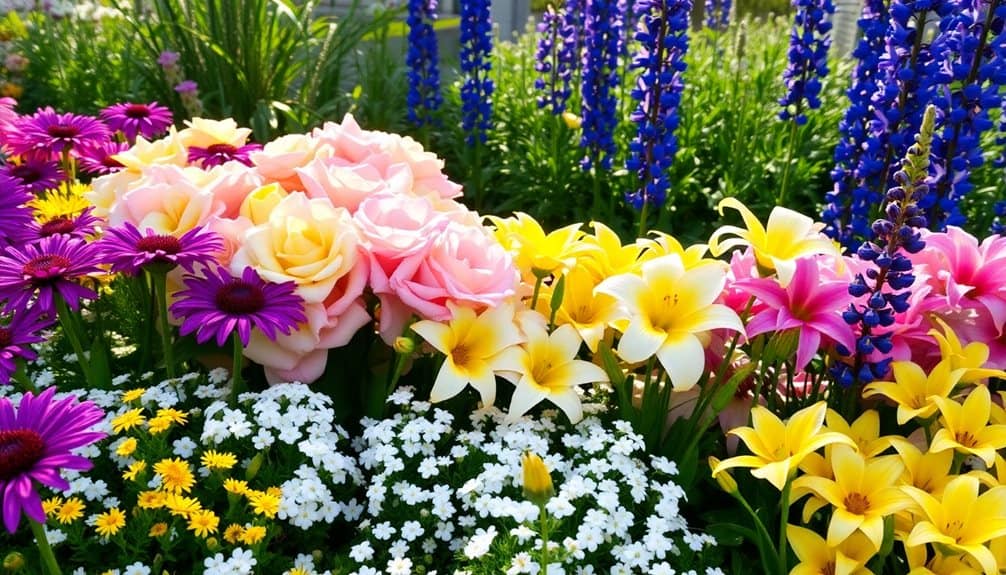
Creating a cohesive color scheme establishes the visual foundation of your flower garden’s design aesthetic. Start by selecting a primary color palette using the color wheel as your guide. You’ll want to choose between monochromatic, complementary, or triadic color combinations for maximum visual impact.
For monochromatic schemes, select flowers in varying shades and tints of a single hue, such as deep purple delphiniums paired with lavender salvias. Complementary color schemes utilize opposite colors on the wheel – try yellow daylilies with purple coneflowers for dramatic contrast. Triadic schemes incorporate three equidistant colors, like orange marigolds, purple verbena, and green ornamental grasses.
Consider bloom times when planning your palette. You’ll need to layer early, mid, and late-season bloomers to maintain consistent color throughout the growing season. Factor in foliage colors as well – silver-leafed plants like dusty miller can serve as neutral bridges between bold flower colors. Don’t forget about color echo – repeating specific hues throughout the garden creates visual rhythm and unity. Use the 60-30-10 rule: 60% dominant color, 30% secondary color, and 10% accent color. To protect your garden’s vibrant colors year-round, position decorative elements in partially shaded areas to minimize UV damage and color fading.
Choose Year-Round Blooming Plants

Selecting year-round bloomers requires strategic planning across four distinct seasonal windows to guarantee continuous garden interest. Begin by identifying your USDA hardiness zone, then layer your planting scheme with spring ephemerals, summer perennials, autumn-flowering specimens, and winter-hardy varieties. Consider incorporating both herbaceous and woody flowering plants to maximize bloom succession.
For ideal year-round performance, integrate these essential plant categories:
- Early-season bulbs and corms (Galanthus, Crocus, Narcissus) shifting to late-spring flowering shrubs (Rhododendron, Viburnum)
- Mid-season herbaceous perennials (Echinacea, Rudbeckia, Phlox) paired with repeat-blooming roses
- Late-season performers including Aster, Chrysanthemum, and ornamental grasses for structural interest
Implement strategic deadheading and succession planting techniques to extend blooming periods. Incorporate evergreen specimens like Helleborus and winter-flowering Mahonia for cold-season interest. Cross-reference bloom times when selecting plant combinations, ensuring at least three species are flowering simultaneously in each seasonal window. Monitor microclimates within your garden space to enhance plant placement and flowering performance. Using quality potting soil will provide essential nutrients and proper drainage to support healthy year-round blooms.
Map Plant Heights
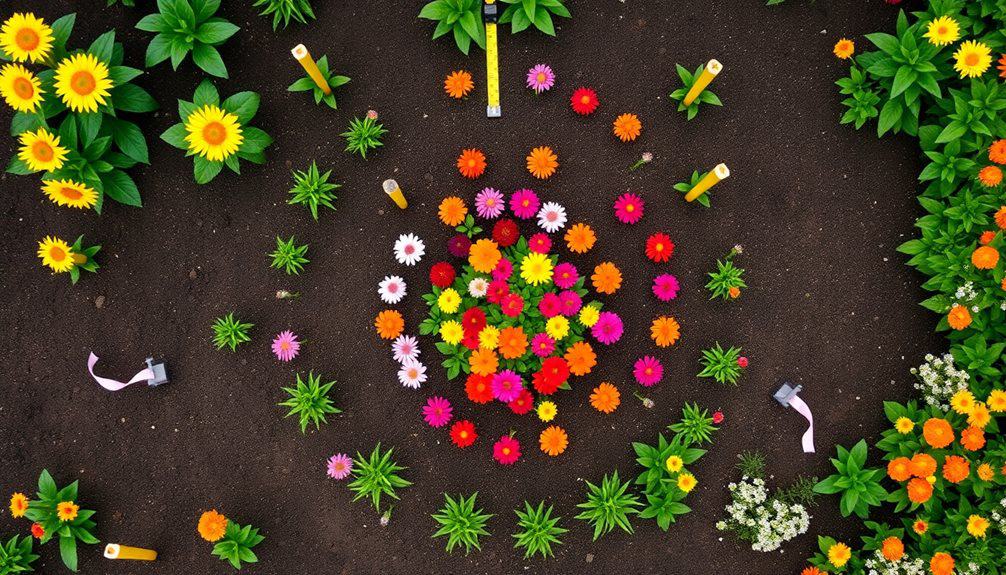
Three distinct vertical layers form the foundation of a well-designed flower garden: ground covers (0-12 inches), middle-story perennials (1-3 feet), and tall background plants (3-8 feet).
You’ll want to position your tallest specimens along the northern border to prevent unwanted shade patterns. Create a planting grid with 1-foot intervals, then mark each plant’s mature spread radius. This guarantees proper spacing and prevents overcrowding as specimens reach full size.
In the ground cover layer, incorporate creeping phlox, sedum, or ajuga for dense coverage. The middle story should feature reliable bloomers like coneflowers, salvias, and daylilies. Your background layer calls for architectural elements such as delphinium, hollyhock, or ornamental grasses.
Consider each plant’s growth habit – whether it’s columnar, mounding, or spreading – when mapping heights. You’ll need to account for seasonal variations, as some perennials may collapse or require staking after flowering. Don’t forget to factor in structural elements like trellises or garden walls, which can affect your height calculations and create microclimates within the planting zones.
Create Garden Paths

Well-designed garden paths serve multiple functions within your flower garden: providing maintenance access, directing foot traffic, and establishing visual flow between planting zones. When creating paths, consider using permeable materials that allow water infiltration while maintaining structural integrity. Popular options include decomposed granite, flagstone, or crushed gravel with proper base preparation.
Your path width should accommodate intended use: maintenance paths require 30-36 inches for wheelbarrow access, while secondary paths can be 24-30 inches wide. Install edge restraints using metal, plastic, or stone to prevent material migration and maintain crisp boundaries.
Key considerations for successful garden path installation:
- Calculate proper slope gradients (1-2%) to guarantee adequate drainage away from planting beds
- Layer materials properly: 4-inch compacted base, 2-inch setting bed, and 2-inch surface material
- Position paths to create intentional viewpoints and focal areas within the garden
Remember to integrate path curves that complement your garden’s style – gentle sweeping curves for informal gardens or straight angular paths for formal designs. Include periodic wider sections for resting spots or maintenance staging areas where appropriate.
Install Proper Drainage
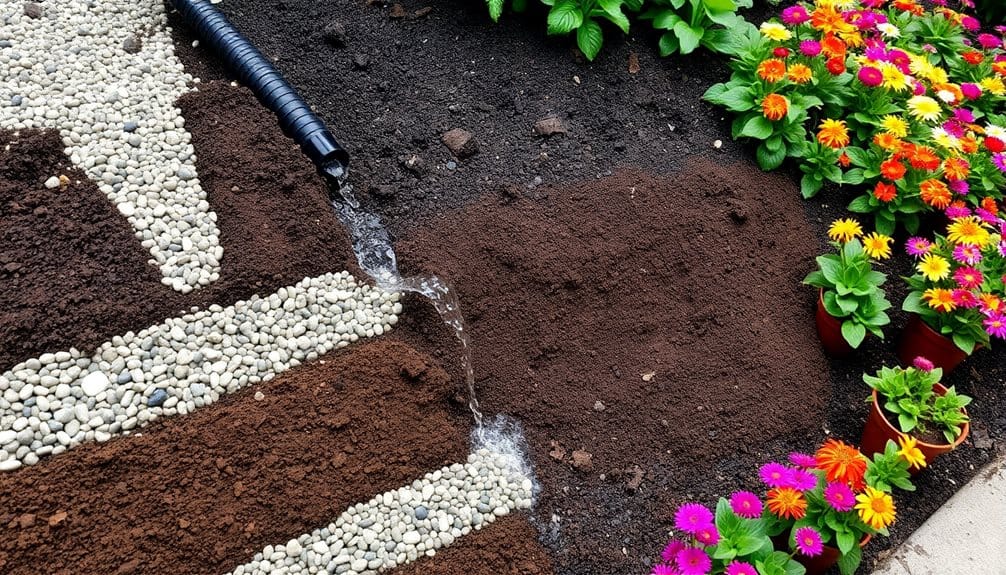
Proper drainage serves as the cornerstone of a thriving flower garden, preventing waterlogged soil and root rot that can devastate your plantings. You’ll need to assess your soil’s percolation rate by conducting a simple drainage test: dig a 12-inch hole, fill it with water, and monitor the time it takes to drain completely.
To establish effective drainage, you’ll want to implement a multi-layered approach. Install French drains with 4-inch perforated PVC pipes surrounded by crushed gravel at strategic low points. Grade the soil with a 2% slope away from structures, ensuring water flows naturally toward designated drainage areas. For clay-heavy soils, incorporate organic matter and coarse sand to improve porosity.
Don’t forget to install catch basins at key collection points, connecting them to your main drainage system with solid PVC pipe. In raised beds, create a foundation layer of crushed stone topped with landscape fabric before adding soil. If you’re dealing with persistent drainage issues, consider installing a dry well system that can handle overflow during heavy rain events. Remember to maintain a minimum 1:4 ratio for vertical to horizontal drainage slope.
Add Garden Infrastructure
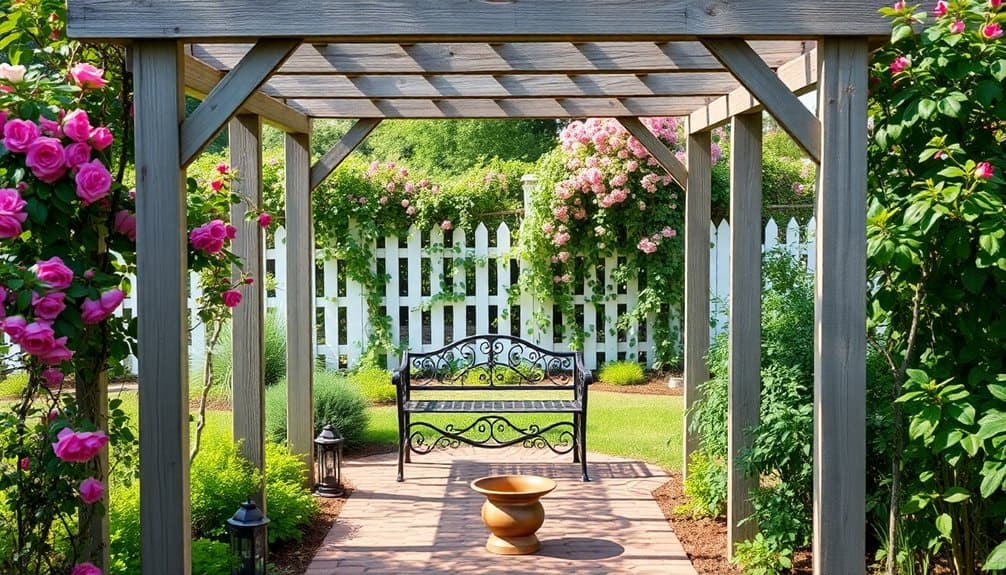
A garden’s foundational infrastructure creates the essential framework for long-term success and efficient maintenance. You’ll need to strategically implement hardscape elements and support systems before introducing plant material. Start by installing permanent irrigation zones, incorporating both drip lines and overhead sprinklers calibrated to your specific soil conditions and planned plant groupings.
Consider these critical infrastructure components:
- Install pathway systems using permeable materials like decomposed granite or stepping stones, maintaining a minimum width of 36 inches for primary walkways and 24 inches for secondary paths
- Establish permanent edging using materials such as steel, aluminum, or concrete to create clean separations between planting beds and maintain mulch containment
- Implement lighting systems with low-voltage LED fixtures, including path lights at 6-8 foot intervals and uplighting for focal points
Don’t overlook the installation of conduit for future electrical needs and strategic placement of hose bibbs every 50-75 feet. You’ll also want to incorporate permanent staking systems for climbing plants and trellises, ensuring they’re anchored at least 24 inches below grade for stability in various weather conditions.
Schedule Maintenance Tasks

With your infrastructure firmly in place, you’ll need to establish a systematic maintenance calendar to protect your garden investment. Create a thorough schedule that addresses daily, weekly, monthly, and seasonal tasks to enhance plant health and garden aesthetics.
Daily monitoring should include deadheading spent blooms, checking soil moisture levels, and inspecting for pest damage. Schedule weekly tasks like deep watering for established plants, edging beds, and removing emergent weeds before they set seed. Monthly maintenance encompasses fertilization applications, pruning for shape and size control, and mulch redistribution where needed.
Your seasonal checklist should detail specific timing for spring bulb division, summer pruning of spring-flowering shrubs, fall perennial cutbacks, and winter protection installations. Include pH testing twice yearly, soil amendment incorporation during dormant seasons, and rotation of annual plantings. Don’t forget to schedule equipment maintenance – sharpen pruners quarterly, clean irrigation systems monthly, and calibrate soil moisture meters seasonally. Document all maintenance activities in a garden journal, noting weather patterns, bloom times, and pest occurrences to refine your schedule for best results year after year.
Frequently Asked Questions
How Do I Keep Rabbits and Deer From Eating My Garden Flowers?
You’ll need a multi-layered defense against herbivorous pests. Install 8-foot deer fencing with buried mesh extending 6 inches below ground. Apply commercial repellents containing putrescent egg solids or predator urine around your garden’s perimeter. Integrate deer-resistant plants like lavender, yarrow, and daffodils. For rabbits, spray capsaicin-based deterrents bi-weekly and maintain physical barriers like chicken wire at 2-foot heights.
What Flowers Are Safe to Plant if I Have Pets?
You’ll want to focus on pet-safe flowering species like African violets, roses, sunflowers, zinnias, and marigolds. Avoid toxic varieties such as lilies, foxglove, daffodils, and tulips, which can cause severe gastrointestinal distress or organ failure in cats and dogs. Install elevated planters or dedicated fenced areas to create physical barriers between your pets and any potentially harmful specimens you’d like to incorporate into your landscape design.
Should I Start My Flowers From Seeds or Buy Mature Plants?
Starting from seeds lets you access a broader variety of cultivars and saves money, but you’ll need to start 6-8 weeks before your zone’s last frost date. Mature plants offer instant gratification and better success rates for beginners, though they’re pricier. If you’re growing perennials, opt for established plants to get blooms in the first season. For annuals, you can experiment with both methods without significant risk.
How Far Apart Should I Space Different Types of Flowers?
You’ll need to follow standard spacing guidelines based on each flower’s mature spread diameter. Space tall perennials like delphiniums 18-24 inches apart, medium-height plants like coneflowers 12-18 inches, and compact varieties like marigolds 6-12 inches. Check your seed packets or plant tags for specific requirements, as overcrowding can lead to poor air circulation and disease susceptibility. Consider each plant’s growth habit and ultimate size when plotting your layout.
Which Flowers Attract the Most Butterflies and Hummingbirds to My Garden?
You’ll attract pollinators with nectar-rich, tubular blooms. For butterflies, plant Buddleia (butterfly bush), Echinacea, Lantana, and Asclepias (milkweed). Hummingbirds favor red, tubular flowers like Monarda (bee balm), Lobelia cardinalis, Penstemon, and Aquilegia (columbine). Plant these specimens in clusters, ensuring continuous bloom cycles throughout the growing season. Native varieties typically yield the highest pollinator activity rates.

